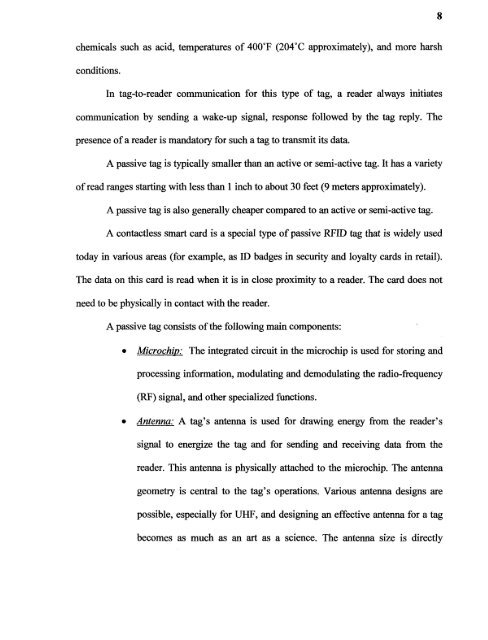Non-foster matching of an RFID antenna - New Jersey Institute of ...
Non-foster matching of an RFID antenna - New Jersey Institute of ...
Non-foster matching of an RFID antenna - New Jersey Institute of ...
You also want an ePaper? Increase the reach of your titles
YUMPU automatically turns print PDFs into web optimized ePapers that Google loves.
8<br />
chemicals such as acid, temperatures <strong>of</strong> 400°F (204°C approximately), <strong>an</strong>d more harsh<br />
conditions.<br />
In tag-to-reader communication for this type <strong>of</strong> tag, a reader always initiates<br />
communication by sending a wake-up signal, response followed by the tag reply. The<br />
presence <strong>of</strong> a reader is m<strong>an</strong>datory for such a tag to tr<strong>an</strong>smit its data.<br />
A passive tag is typically smaller th<strong>an</strong> <strong>an</strong> active or semi-active tag. It has a variety<br />
<strong>of</strong> read r<strong>an</strong>ges starting with less th<strong>an</strong> 1 inch to about 30 feet (9 meters approximately).<br />
A passive tag is also generally cheaper compared to <strong>an</strong> active or semi-active tag.<br />
A contactless smart card is a special type <strong>of</strong> passive <strong>RFID</strong> tag that is widely used<br />
today in various areas (for example, as ID badges in security <strong>an</strong>d loyalty cards in retail).<br />
The data on this card is read when it is in close proximity to a reader. The card does not<br />
need to be physically in contact with the reader.<br />
A passive tag consists <strong>of</strong> the following main components:<br />
• Microchip: The integrated circuit in the microchip is used for storing <strong>an</strong>d<br />
processing information, modulating <strong>an</strong>d demodulating the radio-frequency<br />
(RF) signal, <strong>an</strong>d other specialized functions.<br />
• Antenna: A tag's <strong>an</strong>tenna is used for drawing energy from the reader's<br />
signal to energize the tag <strong>an</strong>d for sending <strong>an</strong>d receiving data from the<br />
reader. This <strong>an</strong>tenna is physically attached to the microchip. The <strong>an</strong>tenna<br />
geometry is central to the tag's operations. Various <strong>an</strong>tenna designs are<br />
possible, especially for UHF, <strong>an</strong>d designing <strong>an</strong> effective <strong>an</strong>tenna for a tag<br />
becomes as much as <strong>an</strong> art as a science. The <strong>an</strong>tenna size is directly
















